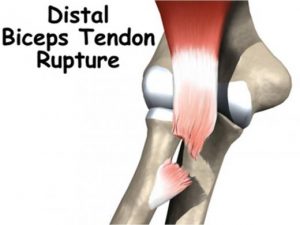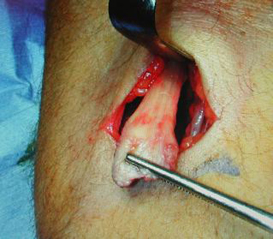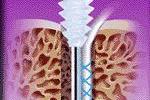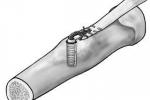What is a biceps tendon rupture?
A biceps tendon rupture is an injury that occurs to the biceps tendon causing the attachment to separate from the bone. A normal biceps tendon is connected strongly to the bone. When the biceps tendon ruptures, this tendon is detached. Following a biceps tendon rupture, the muscle cannot pull on the bone, and certain movements may be weakened and painful.
There are two types of biceps tendon ruptures
Proximal Biceps Tendon Ruptures
A proximal biceps tendon rupture is an injury to the biceps tendon at the shoulder joint. This injury type is the most common type of biceps tendon injury (rupture of the proximal biceps tendon comprises 90-97% of all biceps ruptures and almost exclusively involves the long head). It is most common in patients over 60 years of age, and often causes minimal symptoms. Rupture of the proximal head of the biceps tendon involves one of two heads of the biceps tendon. This condition usually occurs in older individuals and is caused by degenerative changes within the biceps tendon leading to failure of the structure. Most patients have preceding shoulder pain consistent with impingement syndrome or a rotator cuff tear. The proximal biceps tendon rupture may then occur during a trivial activity, and some patients may experience some pain relief once the damaged tendon ruptures.
The proximal biceps tendon can rupture in a younger patient with activities such as weight-lifting or throwing sports, but this is quite unusual.
What are the symptoms of a proximal biceps tendon rupture?
Usually patients will have sudden pain associated with an audible snap in the area of their shoulder. The pain is usually not significant, and, as mentioned previously, some patients may experience pain relief after the rupture. After the ruptured tendon retracts, patients may notice a bulge in their arm at the biceps muscle. This is the retracted muscle bunched up in the arm, and is sometime referred to as a “Popeye Muscle,” because the muscle is more pronounced than normal.
What is the treatment for a proximal biceps tendon rupture?
Patients usually do not notice any loss of arm or shoulder function following a proximal biceps tendon rupture. A slight bulge in the arm, and some twitching of the retracted muscle are usually the most significant symptoms. Surgical repair of the proximal biceps tendon is usually only considered in the case of a younger patient who is more active.
The reason there is little functional loss following a proximal biceps tendon rupture is that there are actually two tendinous attachments of the biceps at the shoulder joint (that is why the muscle is named “bi-ceps,” meaning two heads). When the rupture occurs at the distal biceps tendon at the elbow, where there is only one attachment, surgical repair is much more commonly needed.
 Distal Biceps Tendon RupturesDistal Biceps Tendon Ruptures
Distal Biceps Tendon RupturesDistal Biceps Tendon Ruptures
The distal biceps tendon is injured around the elbow joint. This is usually an injury that occurs with heavy lifting or sports in middle-aged men. Most patients with a distal biceps rupture will have surgery to repair the torn tendon. Rupture of the distal biceps tendon at the elbow joint is much less common and accounts for less than 5% of biceps tendon ruptures. This injury is also usually found in middle-aged patients, although not always. There is usually some degree of tendinosus, or degenerative changes within the tendon, that predisposes the patient to rupture of the tendon.
The significance of a distal biceps tendon rupture is that without surgical repair, patients who experience complete rupture of the distal biceps tendon will notice loss of strength at the elbow. The strength will affect both the ability to bend the elbow against resistance, and the ability to turn the forearm to the palm-up position against resistance (for example, turning a doorknob or screwdriver).
How is a biceps tendon rupture diagnosed?
Distal biceps tendon rupture is characterized by sudden pain over the front of the elbow after a forceful effort against a flexed elbow. Usually the patient will hear a snap and have pain where the tendon rupture occurs. Swelling and bruising around the elbow are also common symptoms of distal biceps tendon rupture. The patient will demonstrate weakness to supination (turning the palm to the sky against resistance).
Biceps tendon ruptures are confirmed on MRI.

What is the treatment of distal biceps tendon rupture?
 Most patients will experience benefit if the biceps tendon is repaired surgically. If the tear is incomplete, or if the patient is very low-demand (not active), then surgery may not be needed. However, most patients who want more normal use of their arm will benefit from surgery to repair the ruptured tendon to the bone.
Most patients will experience benefit if the biceps tendon is repaired surgically. If the tear is incomplete, or if the patient is very low-demand (not active), then surgery may not be needed. However, most patients who want more normal use of their arm will benefit from surgery to repair the ruptured tendon to the bone.



